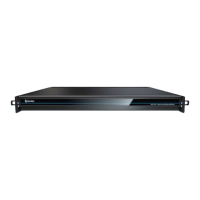6
• Translate up to 8 compatible video sources to SDI or NDI for input, output, or a combination of both
• Configure for dual-channel 4K Ultra HD at 60 frames per second with support for 3G-SDI quad-link
grouping
• Integrate with compatible systems and devices across your network for switching, streaming, display,
and delivery
• Stack modules in a single location or station in multiple locations to meet the demands of your
productions
SECTION 1.3 SETTING UP
1.3.1 COMMAND AND CONTROL
Hint: NC1 IO's interface requires a monitor resolution setting of at least 1280x1024.
1. Connect an external computer monitor to the HDMI
port on the backplate (see Input/Output connections).
2. Connect the mouse and keyboard to USB ports also on
the backplate.
3. Connect the power cord to NC1 IO's backplate.
4. Turn on the computer monitor.
5. Press the Power switch on NC1 IO's faceplate (located
behind the drop-down door).
At this point, the blue Power LED will illuminate, as the device
boots up. (If this does not happen, check your connections
and retry). Though not a requirement, we do strongly
recommend that you connect NC1 IO using an uninterruptable
power supply (UPS), as for any ‘mission critical’ system.
Likewise, consider A/C “power conditioning”, especially in
situations where local power is unreliable or ‘noisy’. Surge
protection is especially important in some locales. Power
conditioners can reduce wear on NC1 IO's power supplies and
other electronics, and provide a further measure of protection
from surges, spikes, lightning and high voltage.
‘Modified sine wave’ UPS devices are
popular due to low manufacturing
costs. However, such units should
generally be viewed as being of low
quality and possibly inadequate to

